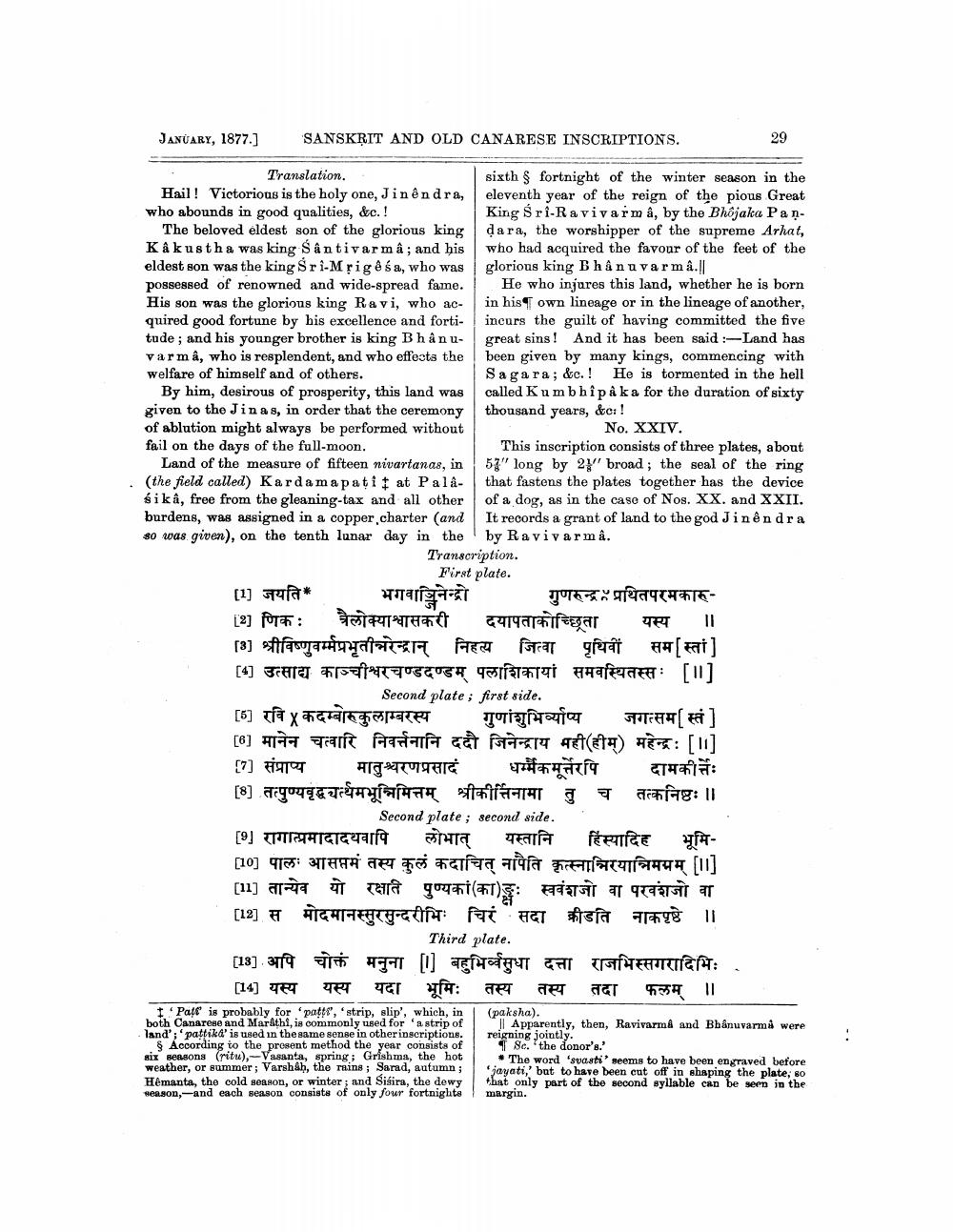________________
JANUARY, 1877.]
SANSKRIT AND OLD CANARESE INSCRIPTIONS.
29
Translation.
sixth fortnight of the winter season in the Hail! Victorious is the holy one, Jinêndra, eleventh year of the reign of the pious Great who abounds in good qualities, &c.!
King Sri-Ravivarmà, by the Bhojaka Pan. The beloved eldest son of the glorious king dara, the worshipper of the supreme Arhat, Kakustha was king Sântivarma; and his who had acquired the favour of the feet of the eldest son was the king Sri-Mrige sa, who was glorious king Bhanu var ma.|| possessed of renowned and wide-spread fame. He who injures this land, whether he is born His son was the glorious king Ravi, who ac- | in his own lineage or in the lineage of another, quired good fortune by his excellence and forti- ! incurs the guilt of having committed the five tude ; and his younger brother is king Bh â nu- great sins! And it has been said:-Land has varma, who is resplendent, and who effects the been given by many kings, commencing with welfare of himself and of others.
Sagara; &c.! He is tormented in the hell By him, desirous of prosperity, this land was called Kumbhîpå ka for the duration of sixty given to the Jinas, in order that the ceremony thousand years, &c: ! of ablution might always be performed without
No. XXIV. fail on the days of the full-moon.
This inscription consists of three plates, about Land of the measure of fifteen nivartanas, in 57" long by 21 broad; the seal of the ring (the field called) Karda m apatit at Pala- that fastens the plates together has the device sikâ, free from the gleaning-tax and all other of a dog, as in the case of Nos. X. and XXII. burdens, was assigned in a copper charter (and It records a grant of land to the god Jinên dra 80 was given), on the tenth lunar day in the ' by Ravivarma.
Transcription.
First plate. [1] जयति* भगवाजिनेन्द्रो गुणरुन्द्र प्रथितपरमकारु[2] णिक: त्रैलोक्याश्वासकरी दयापताकोच्छ्तिा यस्य ॥ [3] श्रीविष्णुवर्मप्रभृतीनरेन्द्रान् निहत्य जित्वा पृथिवीं सम[स्ता] [4] उत्साद्य काञ्चीश्वरचण्डदण्डम् पलाशिकायां समवस्थितस्सः [1]
Second plate; first side. [5] रवि x कदम्बोरुकुलाम्बरस्य गुणांशुभिर्व्याप्य जगत्सम स्तं] [6] मानेन चत्वारि निवर्त्तनानि ददौ जिनेन्द्राय मही(हीम्) महेन्द्र: [1] [7] संप्राप्य मातुश्चरणप्रसाद धम्मैकमूर्तेरपि दामकीर्तेः [8] तत्पुण्यवृद्धचर्थमभून्निमित्तम् श्रीकीर्तिनामा तु च तत्कनिष्ठः॥
Second plate; second side. [9] रागात्प्रमादादथवापि लोभात् यस्तानि हिंस्यादिह भूमि[10] पालः आसप्तमं तस्य कुलं कदाचित् नापति कृत्स्नान्निरयान्निममम [1] [11] तान्येव यो रक्षात पुण्यकां(का)ङ्गः स्ववंशजो वा परवंशजो वा [12] स मोदमानस्सुरसुन्दरीभिः चिरं सदा क्रीडति नाकपृष्ठे ॥
Third plate. [13] अपि चोक्तं मनुना D] बहुभिर्वसुधा दत्ता राजभिस्सगरादिभिः .
[14] यस्य यस्य यदा भूमिः तस्य तस्य तदा फलम् ॥ + Patr is probably for 'patel', 'strip, slip', which, in | (paksha). both Canarese and Marathi, is commonly used for a strip of || Apparently, then, Ravivarma and Bhanuvarma were - land'; 'pattika' is used in thesame sense in other inscriptions, reigning jointly.
According to the present method the year consists of Sc. the donor's.' six seasons (ritu), -Vasanta, spring; Grishma, the hot
The word 'svasti seems to have been engraved before weather, or summer; Varshah, the rains ; Sarad, autumn;
| jayati,' but to have been cut off in shaping the plate, so Hémanta, the cold season, or winter, and Sisira, the dewy that only part of the second syllable can be seen in the season, and each season consists of only four fortnight m argin.




